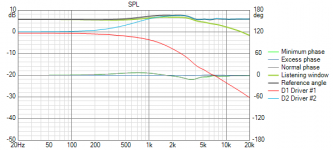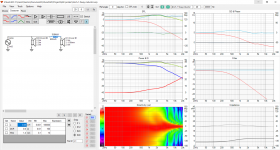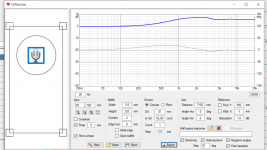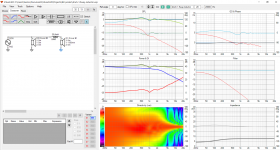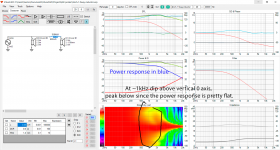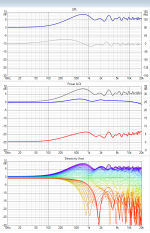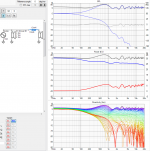Hello, coming back to this topic..
As an example, two 4" full range drivers wired in parallel with inductor on one driver, both front baffle mounted. 1st order crossover is at say, 600hz.
With the phase shift on .5 driver, how much of frequency band is affected and other potential issues?
As an example, two 4" full range drivers wired in parallel with inductor on one driver, both front baffle mounted. 1st order crossover is at say, 600hz.
With the phase shift on .5 driver, how much of frequency band is affected and other potential issues?
Hi,
VituixCAD simulation with ideal drivers, on a smallest possible baffle attached to demonstrate. The crossover needs to be lower than 600Hz to counteract the bafflestep in the demonstration. If the baffle is bigger, even lower crossover is needed. Can't get flat response on axis with single inductor. The hump is within few db which might be fine.
With smallest possible baffle the diffraction effects (which bafflestep relates to) has narrowest bandwidth, still over about a decade or how it is said. In this case roughly 200-2000Hz and beyond.
The responses for the drivers are made in VituixCad diffraction simulator. Hope it helps.
edit. diffraction tool was set for 7.1meter listening distance and crossover simulation has only 10cm c-2-c 😀 well, there is not too much difference for the demonstration purpose.
VituixCAD simulation with ideal drivers, on a smallest possible baffle attached to demonstrate. The crossover needs to be lower than 600Hz to counteract the bafflestep in the demonstration. If the baffle is bigger, even lower crossover is needed. Can't get flat response on axis with single inductor. The hump is within few db which might be fine.
With smallest possible baffle the diffraction effects (which bafflestep relates to) has narrowest bandwidth, still over about a decade or how it is said. In this case roughly 200-2000Hz and beyond.
The responses for the drivers are made in VituixCad diffraction simulator. Hope it helps.
edit. diffraction tool was set for 7.1meter listening distance and crossover simulation has only 10cm c-2-c 😀 well, there is not too much difference for the demonstration purpose.
Attachments
Last edited:
Huge 60cm wide and 120cm high baffle as example, lower xo needed.
These are quick demonstrations about the effects involved and not a design for real world application.
These are quick demonstrations about the effects involved and not a design for real world application.
Attachments
Last edited:
At the BSC corner frequency the 0.5 woofer is lagging by 45degrees in phase. If you make the 0.5 woofer the lower one, then at the BSC above listening axis you lose a 1-2 dB as the lower woofer lags by more and more due to extra path distance. Below the listening axis you gain 1-2 dB as the path length becomes shorter and cancels out some of the phase lag from the inductor.
The effect is usually only over a couple hundred Hz range as below the corner the filter has no effect and above the 0.5 woofer is rolled off significantly. Severity depends on woofer spacing also.
There is some discussion and a polar plot showing that the listening axis tilts down at the BSC here:
Zaph|Audio - ZDT3.5
The effect is usually only over a couple hundred Hz range as below the corner the filter has no effect and above the 0.5 woofer is rolled off significantly. Severity depends on woofer spacing also.
There is some discussion and a polar plot showing that the listening axis tilts down at the BSC here:
Zaph|Audio - ZDT3.5
^Also visible in the example above. The same image attached with legend for clarity 😀
I don't think that is of much concern since the drivers beam so much the listening window is small anyway, and it doesn't show up in the power response.
If listening axis is above 0deg vertical, the on-axis hump at 1khz would flatten a bit, but the treble would be gone as well. This is ideal case though, real world drivers would have their own response.
ps. VituixCAD is pretty awesome to test all kinds of ideas, takes only a minute to make such ideal drivers on a baffle example.
I don't think that is of much concern since the drivers beam so much the listening window is small anyway, and it doesn't show up in the power response.
If listening axis is above 0deg vertical, the on-axis hump at 1khz would flatten a bit, but the treble would be gone as well. This is ideal case though, real world drivers would have their own response.
ps. VituixCAD is pretty awesome to test all kinds of ideas, takes only a minute to make such ideal drivers on a baffle example.
Attachments
Last edited:
For the purpose of focussing on the baffle, a point source might make for the ideal driver.VituixCAD simulation with ideal drivers,
In the bigger picture, the hump is not as big of a concern as the axial response makes it appear.Can't get flat response on axis with single inductor. The hump is within few db which might be fine.
Image 1, single driver, showing the hump as an acoustic concern that shouldn't be taken at face value.
Image 2, 1.5 way, showing that the hump is partially correctable.
Image 3, showing that the matter changes as you move off axis, partially resolving itself.
Attachments
^ yeah corrected to the previous post that power response is pretty flat so not too much to worry about.
Not sure point source is good for testing stuff out since it doesn't connect with reality having 0 physical size which is not possible in reality. The ideal drivers that have flat response 20Hz-20000Hz to all directions are not real either but at least they have physical property in size and give better idea how the driver and baffle fit and act together best possible case. Real drivers have same relation with physical size to sound wavelengths but have additional issues on top.
Not sure point source is good for testing stuff out since it doesn't connect with reality having 0 physical size which is not possible in reality. The ideal drivers that have flat response 20Hz-20000Hz to all directions are not real either but at least they have physical property in size and give better idea how the driver and baffle fit and act together best possible case. Real drivers have same relation with physical size to sound wavelengths but have additional issues on top.
Last edited:
This is fascinating, so one cd tailor the midrange to be lean or full depending on the listening axis or even turning the speakers upside down etc.At the BSC corner frequency the 0.5 woofer is lagging by 45degrees in phase. If you make the 0.5 woofer the lower one, then at the BSC above listening axis you lose a 1-2 dB as the lower woofer lags by more and more due to extra path distance. Below the listening axis you gain 1-2 dB as the path length becomes shorter and cancels out some of the phase lag from the inductor
Thanks so much for the contributions, it's alot to read and understand but now see alot of positives for 1.5way designs
@ tmuikku, that is the beauty of the ideal model. It dispenses with reality in some ways, in order to more clearly show others.
^^Allen Yep, there might be use cases for point source to reveal some phenomena or help with thinking from another point of view. Maybe to trick a simulator (the ripple tank for example) is useful to see how waves interact with physical objects.
My philosophy using the "ideal piston with size" instead of point source comes from the fact that sound has propagation speed through medium which dictate physical size of the sound waves. Even if technology was advanced enough to have perfect piston drivers, or pulsating point in space, we'd still have to deal with the sound waves having varying size. This is kind of the fundamental for speaker design, "physical size of sound".
I'm not sure if pulsating point in space would work if it existed since low frequencies still require displacement and a point would need some size. Anyway, going too far of into the philosophy, which is very interesting but not for this topic 😀
edit. further into philosophy, I believe we can ditch the physical speakers before perfect piston comes to reality. Stimulate the brain directly skipping the vibration in air and the ear altogether 😀 hmm, we'd still need something physical to kick in the chest with the beat though.. unless the entire sensory system was stimulated directly. Something to the topic: double 4" don't kick in the chest either so easier to stimulate into brain than a proper sensory tingling musical sensation.
My philosophy using the "ideal piston with size" instead of point source comes from the fact that sound has propagation speed through medium which dictate physical size of the sound waves. Even if technology was advanced enough to have perfect piston drivers, or pulsating point in space, we'd still have to deal with the sound waves having varying size. This is kind of the fundamental for speaker design, "physical size of sound".
I'm not sure if pulsating point in space would work if it existed since low frequencies still require displacement and a point would need some size. Anyway, going too far of into the philosophy, which is very interesting but not for this topic 😀
edit. further into philosophy, I believe we can ditch the physical speakers before perfect piston comes to reality. Stimulate the brain directly skipping the vibration in air and the ear altogether 😀 hmm, we'd still need something physical to kick in the chest with the beat though.. unless the entire sensory system was stimulated directly. Something to the topic: double 4" don't kick in the chest either so easier to stimulate into brain than a proper sensory tingling musical sensation.
Last edited:
- Home
- Loudspeakers
- Multi-Way
- 90° phase shift in 1.5 way designs
